1955 Maserati 300S


1955 Maserati 300S
Manufacturer:
Model year:
Country:
Generation:
Portal:
Category:
About this car
Discover the history
The 1955 Maserati 300S is one of the most iconic sports racing cars of its era, known for both its exceptional design and performance. Developed by Maserati for competition in endurance racing, it was a direct response to the success of Ferrari and Jaguar, and aimed to further establish Maserati’s prowess in sports car racing. Its inception followed the success of the Maserati 250F in Formula One, and the 300S borrowed key mechanical elements from that car, particularly its engine.
The heart of the 300S was a 3.0-liter straight-six engine, which evolved from the 250F’s powerplant. This engine produced about 245 horsepower and enabled the car to reach speeds of up to 170 mph, impressive for its time. Its construction featured advanced technologies for the mid-1950s, including twin overhead camshafts, dual ignition, and triple Weber carburetors. These components made the car not only fast but also responsive, characteristics that were crucial for competing in endurance races. The lightweight aluminum body, combined with a tubular steel chassis, gave the 300S its notable agility and handling capabilities.
The Maserati 300S made its racing debut in 1955, though its early outings were marred by mechanical issues and development teething problems. Nonetheless, by 1956, the car began to fulfill its potential. Its first major success came at the Nürburgring 1000 km, where it triumphed, contributing significantly to the car’s legacy. The same year, it secured victory at the Targa Florio, one of the most grueling road races in the world, further cementing its reputation as a durable and competitive racing machine.




Although factory-backed entries of the 300S were successful, much of its legacy comes from privateer racers. Maserati built around 28 units, many of which were sold to private teams, which competed in both European and American events. Stirling Moss, one of the most famous drivers of the era, achieved significant success with the 300S, including a notable victory at the Bahamas Speed Week in 1956. The car’s participation in various prestigious races, such as the 24 Hours of Le Mans and the Mille Miglia, though not always leading to victory, contributed to its iconic status. It was a car that demanded attention both for its performance on the track and for its sleek, aerodynamic design.
The 300S continued to race competitively until 1958, with private teams still fielding the car in various events. It was eventually succeeded by the more powerful Maserati 450S, but the 300S remains one of the most beloved and collectible Maserati sports cars of all time. Today, it is highly prized by collectors and regularly features in historic racing events, where its engineering and design continue to impress.
The Maserati 300S was a blend of innovation and tradition, a reflection of Maserati’s philosophy of building fast, reliable race cars while pushing the envelope of technology. Even after its retirement from competitive racing, the car is regarded as one of the greatest sports racing cars of its time, with many of its models remaining in the hands of collectors, enthusiasts, and historic racers today.



